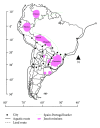What the iberian conquest bequeathed to us: the fruit trees introduced in argentine subtropic-their history and importance in present traditional medicine
- PMID: 24348725
- PMCID: PMC3857738
- DOI: 10.1155/2013/868394
What the iberian conquest bequeathed to us: the fruit trees introduced in argentine subtropic-their history and importance in present traditional medicine
Abstract
This contribution presents information about the history of introduction, establishment, and local appropriation of Eurasian fruit trees-species and varieties of the genera Prunus and Citrus-from 15th century in two rural areas of Northern Argentina. By means of an ethnobotanical and ethnohistorical approach, our study was aimed at analysing how this process influenced local medicine and the design of cultural landscape that they are still part of. As a first step, local diversity, knowledge, and management practices of these fruit tree species were surveyed. In a second moment, medicinal properties attributed to them were documented. A historical literature was consulted referring to different aspects on introduction of peaches and citric species into America and their uses in the past. The appropriation of these fruit-trees gave place to new applications and a particular status for introduced species that are seen as identitary and contribute to the definition of the communities and daily life landscapes. Besides, these plants, introduced in a relatively short period and with written record, allow the researcher to understand and to design landscape domestication, as a multidimensional result of physical, social, and symbolic environment.
Figures





Similar articles
-
Monpa, memory, and change: an ethnobotanical study of plant use in Mêdog County, South-east Tibet, China.J Ethnobiol Ethnomed. 2020 Jan 30;16(1):5. doi: 10.1186/s13002-020-0355-7. J Ethnobiol Ethnomed. 2020. PMID: 32000826 Free PMC article.
-
The use of the local flora in Switzerland: a comparison of past and recent medicinal plant knowledge.J Ethnopharmacol. 2014;151(1):253-64. doi: 10.1016/j.jep.2013.10.035. Epub 2013 Nov 6. J Ethnopharmacol. 2014. PMID: 24211393
-
Plant-based remedies for wolf bites and rituals against wolves in the Iberian Peninsula: Therapeutic opportunities and cultural values for the conservation of biocultural diversity.J Ethnopharmacol. 2017 Sep 14;209:124-139. doi: 10.1016/j.jep.2017.07.038. Epub 2017 Jul 27. J Ethnopharmacol. 2017. PMID: 28755969 Review.
-
Medicinal plants used for traditional veterinary in the Sierras de Córdoba (Argentina): an ethnobotanical comparison with human medicinal uses.J Ethnobiol Ethnomed. 2011 Aug 4;7(1):23. doi: 10.1186/1746-4269-7-23. J Ethnobiol Ethnomed. 2011. PMID: 21816043 Free PMC article.
-
Historical versus contemporary medicinal plant uses in the US Virgin Islands.J Ethnopharmacol. 2016 Nov 4;192:74-89. doi: 10.1016/j.jep.2016.07.005. Epub 2016 Jul 1. J Ethnopharmacol. 2016. PMID: 27377341 Review.
Cited by
-
Medicinal Plant Diversity and Inter-Cultural Interactions between Indigenous Guarani, Criollos and Polish Migrants in the Subtropics of Argentina.PLoS One. 2017 Jan 11;12(1):e0169373. doi: 10.1371/journal.pone.0169373. eCollection 2017. PLoS One. 2017. PMID: 28076407 Free PMC article.
-
Management of Fruit Species in Urban Home Gardens of Argentina Atlantic Forest as an Influence for Landscape Domestication.Front Plant Sci. 2017 Sep 28;8:1690. doi: 10.3389/fpls.2017.01690. eCollection 2017. Front Plant Sci. 2017. PMID: 29033964 Free PMC article.
References
-
- Capparelli A, Hilgert N, Ladio A, et al. Paisajes culturales de Argentina: pasado y presente desde las perspectivas etnobotánicas y paleobotánicas. Revista de la Asociación Argentina de Ecología del Paisaje. 2011;2(2):67–79.
-
- Ochoa J, Ladio A. Pasado y presente del uso de plantas silvestres con órganos de almacenamiento subterráneos comestibles en la Patagonia. Bonplandia. 2011;20(2):265–284.
-
- Pochettino ML, Martínez MR, Crivos M. Landscape domestication among two mbyá-guaraní communities in Misiones, Argentina. In: Stepp JR, Wyndham FS, Zarger RK, editors. Ethnobiology and Biocultural Diversity. Athens, Ga, USA: University of Georgia Press; 2002. pp. 696–704.
-
- Capparelli A, Raffino RA. Arqueoetnobotánica de El Shincal I: tallos finos, frutos y semillas. Tawantinsuyu. 1997;3:40–57.
-
- Giovannetti M. La conquista del noroeste argentino y los cultivos europeos. Fronteras de la Historia. 2005;(10):253–283.
LinkOut - more resources
Full Text Sources
Other Literature Sources
Research Materials
Miscellaneous

